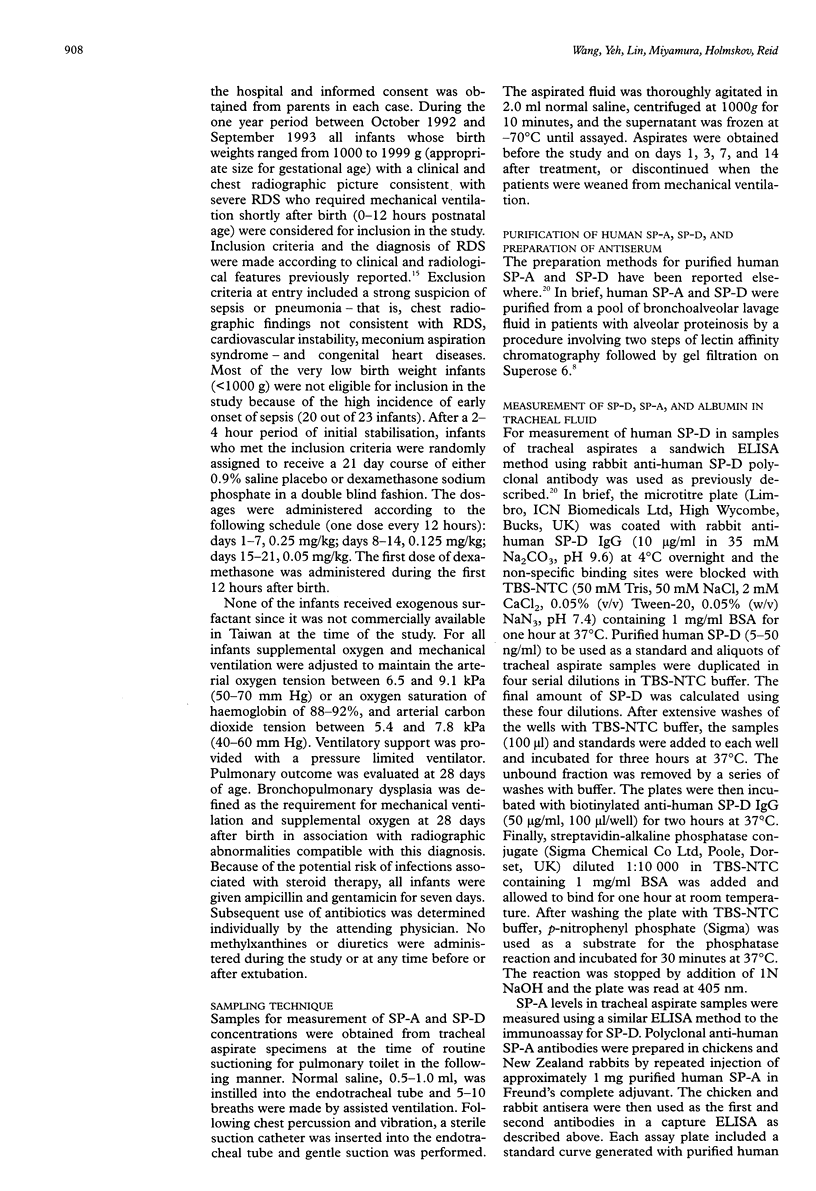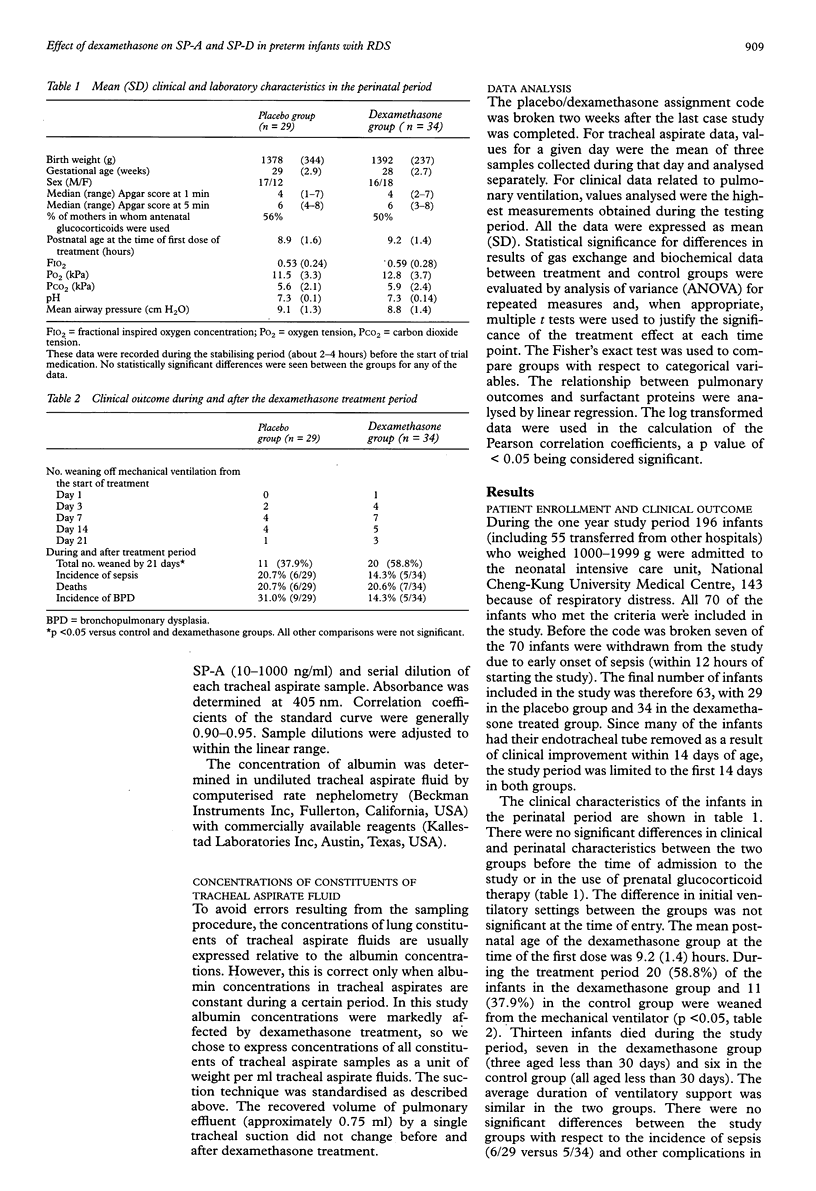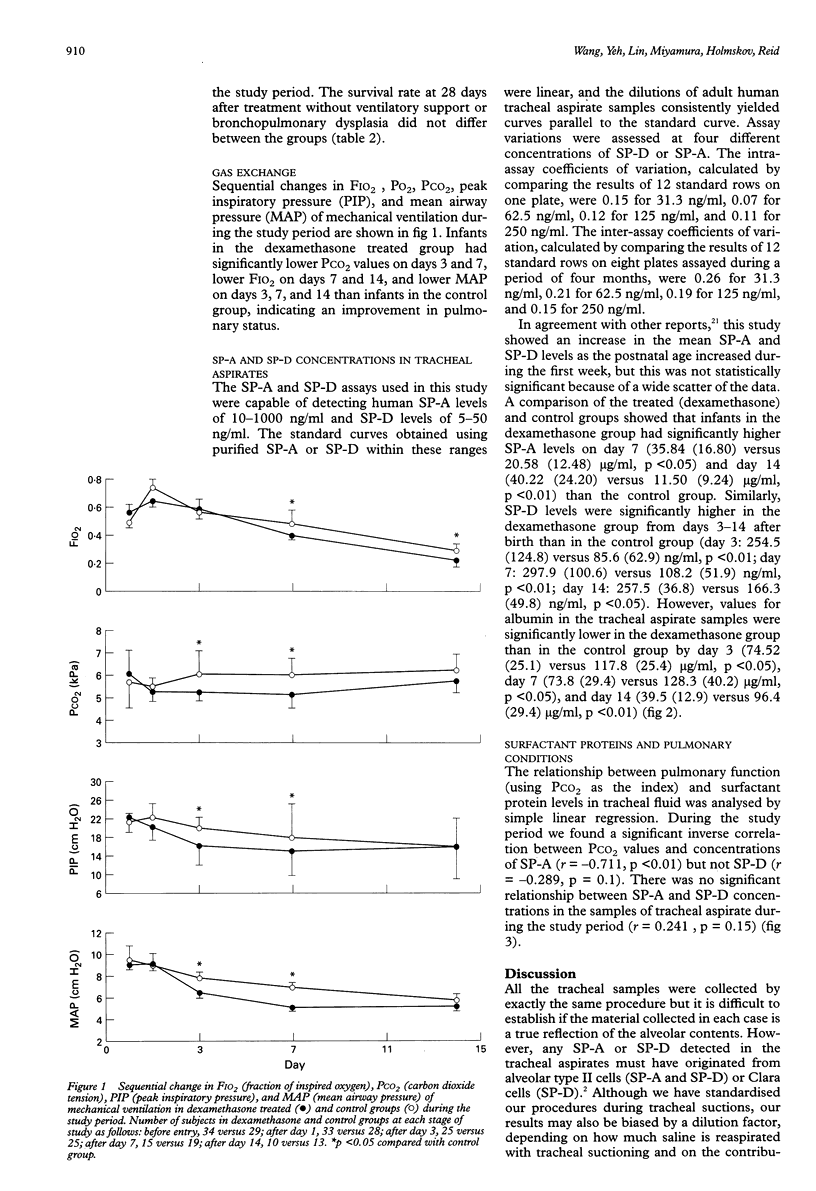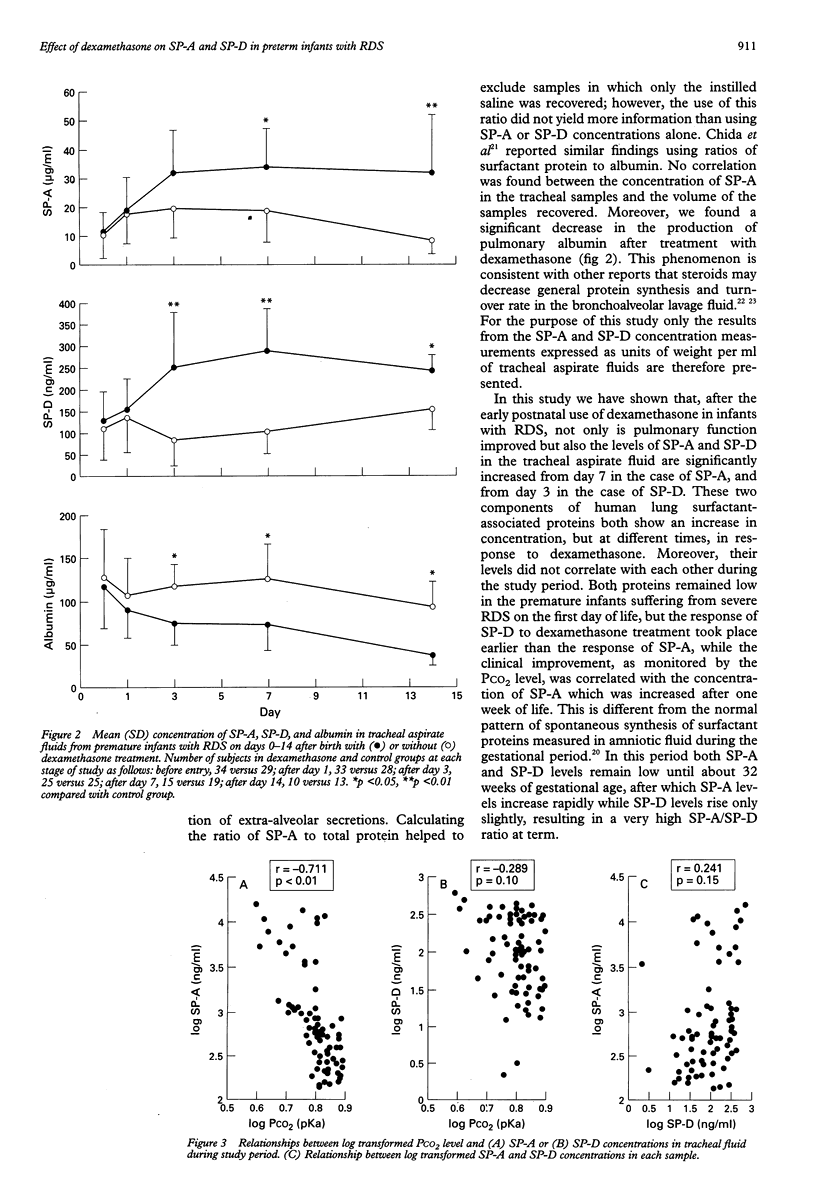Abstract
BACKGROUND: Early postnatal use of dexamethasone in infants with respiratory distress syndrome (RDS) has been shown effectively to improve pulmonary status and to allow early weaning off mechanical ventilation. However, the mechanisms to explain the beneficial effects of dexamethasone in ventilatory dependent preterm infants remain unclear. METHODS: A double blind, placebo controlled study was performed to determine the change in pulmonary ventilation of premature infants with RDS as a result of dexamethasone treatment, and to evaluate the effect of dexamethasone on the levels of surfactant-associated proteins A (SP-A) and D (SP-D) in the tracheal fluid from 34 premature infants with RDS and 29 control subjects. RESULTS: Dexamethasone treatment decreased fractional inspired oxygen concentration (FIO2), arterial carbon dioxide tension (PCO2), mean airway pressure (MAP), and facilitated successful weaning from mechanical ventilation. SP-A concentrations in the tracheal aspirates were increased at days 7 and 14, and SP-D concentrations were increased during the period from days 3 to 14 in the dexamethasone treated group compared with the control group. However, albumin levels in the tracheal aspirate samples were decreased after dexamethasone treatment over the period from days 3 to 14. There was an inverse correlation between PCO2 values and SP-A concentrations. CONCLUSIONS: These results suggest that early use of dexamethasone can improve pulmonary status and also increase SP-A and SP-D levels in the tracheal fluid in premature infants with RDS.
Full text
PDF






Selected References
These references are in PubMed. This may not be the complete list of references from this article.
- Ashton M. R., Postle A. D., Smith D. E., Hall M. A. Surfactant phosphatidylcholine composition during dexamethasone treatment in chronic lung disease. Arch Dis Child. 1994 Sep;71(2):F114–F117. doi: 10.1136/fn.71.2.f114. [DOI] [PMC free article] [PubMed] [Google Scholar]
- Chida S., Phelps D. S., Cordle C., Soll R., Floros J., Taeusch H. W. Surfactant-associated proteins in tracheal aspirates of infants with respiratory distress syndrome after surfactant therapy. Am Rev Respir Dis. 1988 Apr;137(4):943–947. doi: 10.1164/ajrccm/137.4.943. [DOI] [PubMed] [Google Scholar]
- Deterding R. R., Shimizu H., Fisher J. H., Shannon J. M. Regulation of surfactant protein D expression by glucocorticoids in vitro and in vivo. Am J Respir Cell Mol Biol. 1994 Jan;10(1):30–37. doi: 10.1165/ajrcmb.10.1.8292379. [DOI] [PubMed] [Google Scholar]
- Farrell P. M., Avery M. E. Hyaline membrane disease. Am Rev Respir Dis. 1975 May;111(5):657–688. doi: 10.1164/arrd.1975.111.5.657. [DOI] [PubMed] [Google Scholar]
- Fraslon C., Batenburg J. J. Pre-translational regulation of lipid synthesizing enzymes and surfactant proteins in fetal rat lung in explant culture. FEBS Lett. 1993 Jul 5;325(3):285–290. doi: 10.1016/0014-5793(93)81090-m. [DOI] [PubMed] [Google Scholar]
- Fussell J. C., Kelly F. J. Effects of dexamethasone on lung protein turnover. Biochem J. 1991 Jan 1;273(Pt 1):93–97. doi: 10.1042/bj2730093. [DOI] [PMC free article] [PubMed] [Google Scholar]
- Gerdes J. S., Abbasi S., Karp K., Hull W., Whitsett J. A. Surfactant protein-A in bronchoalveolar lavage fluid from neonates with RDS on conventional and high-frequency oscillatory ventilation. Pediatr Pulmonol. 1990;9(3):166–169. doi: 10.1002/ppul.1950090308. [DOI] [PubMed] [Google Scholar]
- Gerdes J. S., Harris M. C., Polin R. A. Effects of dexamethasone and indomethacin on elastase, alpha 1-proteinase inhibitor, and fibronectin in bronchoalveolar lavage fluid from neonates. J Pediatr. 1988 Oct;113(4):727–731. doi: 10.1016/s0022-3476(88)80390-1. [DOI] [PubMed] [Google Scholar]
- Groneck P., Reuss D., Götze-Speer B., Speer C. P. Effects of dexamethasone on chemotactic activity and inflammatory mediators in tracheobronchial aspirates of preterm infants at risk for chronic lung disease. J Pediatr. 1993 Jun;122(6):938–944. doi: 10.1016/s0022-3476(09)90024-5. [DOI] [PubMed] [Google Scholar]
- Holmskov U., Malhotra R., Sim R. B., Jensenius J. C. Collectins: collagenous C-type lectins of the innate immune defense system. Immunol Today. 1994 Feb;15(2):67–74. doi: 10.1016/0167-5699(94)90136-8. [DOI] [PubMed] [Google Scholar]
- Hong S. L., Levine L. Inhibition of arachidonic acid release from cells as the biochemical action of anti-inflammatory corticosteroids. Proc Natl Acad Sci U S A. 1976 May;73(5):1730–1734. doi: 10.1073/pnas.73.5.1730. [DOI] [PMC free article] [PubMed] [Google Scholar]
- Johansson J., Curstedt T., Robertson B. The proteins of the surfactant system. Eur Respir J. 1994 Feb;7(2):372–391. doi: 10.1183/09031936.94.07020372. [DOI] [PubMed] [Google Scholar]
- Lim B. L., Wang J. Y., Holmskov U., Hoppe H. J., Reid K. B. Expression of the carbohydrate recognition domain of lung surfactant protein D and demonstration of its binding to lipopolysaccharides of gram-negative bacteria. Biochem Biophys Res Commun. 1994 Aug 15;202(3):1674–1680. doi: 10.1006/bbrc.1994.2127. [DOI] [PubMed] [Google Scholar]
- Lu J., Willis A. C., Reid K. B. Purification, characterization and cDNA cloning of human lung surfactant protein D. Biochem J. 1992 Jun 15;284(Pt 3):795–802. doi: 10.1042/bj2840795. [DOI] [PMC free article] [PubMed] [Google Scholar]
- Mammel M. C., Green T. P., Johnson D. E., Thompson T. R. Controlled trial of dexamethasone therapy in infants with bronchopulmonary dysplasia. Lancet. 1983 Jun 18;1(8338):1356–1358. doi: 10.1016/s0140-6736(83)92139-6. [DOI] [PubMed] [Google Scholar]
- Miyamura K., Malhotra R., Hoppe H. J., Reid K. B., Phizackerley P. J., Macpherson P., López Bernal A. Surfactant proteins A (SP-A) and D (SP-D): levels in human amniotic fluid and localization in the fetal membranes. Biochim Biophys Acta. 1994 Jan 20;1210(3):303–307. doi: 10.1016/0005-2760(94)90233-x. [DOI] [PubMed] [Google Scholar]
- Moya F. R., Montes H. F., Thomas V. L., Mouzinho A. M., Smith J. F., Rosenfeld C. R. Surfactant protein A and saturated phosphatidylcholine in respiratory distress syndrome. Am J Respir Crit Care Med. 1994 Dec;150(6 Pt 1):1672–1677. doi: 10.1164/ajrccm.150.6.7952631. [DOI] [PubMed] [Google Scholar]
- Ogasawara Y., Kuroki Y., Tsuzuki A., Ueda S., Misaki H., Akino T. Pre- and postnatal stimulation of pulmonary surfactant protein D by in vivo dexamethasone treatment of rats. Life Sci. 1992;50(23):1761–1767. doi: 10.1016/0024-3205(92)90059-x. [DOI] [PubMed] [Google Scholar]
- Rice W. R., Ross G. F., Singleton F. M., Dingle S., Whitsett J. A. Surfactant-associated protein inhibits phospholipid secretion from type II cells. J Appl Physiol (1985) 1987 Aug;63(2):692–698. doi: 10.1152/jappl.1987.63.2.692. [DOI] [PubMed] [Google Scholar]
- Sanders R. J., Cox C., Phelps D. L., Sinkin R. A. Two doses of early intravenous dexamethasone for the prevention of bronchopulmonary dysplasia in babies with respiratory distress syndrome. Pediatr Res. 1994 Jul;36(1 Pt 1):122–128. doi: 10.1203/00006450-199407001-00022. [DOI] [PubMed] [Google Scholar]
- Stevens P. A., Schadow B., Bartholain S., Segerer H., Obladen M. Surfactant protein A in the course of respiratory distress syndrome. Eur J Pediatr. 1992 Aug;151(8):596–600. doi: 10.1007/BF01957730. [DOI] [PubMed] [Google Scholar]
- Suzuki Y., Fujita Y., Kogishi K. Reconstitution of tubular myelin from synthetic lipids and proteins associated with pig pulmonary surfactant. Am Rev Respir Dis. 1989 Jul;140(1):75–81. doi: 10.1164/ajrccm/140.1.75. [DOI] [PubMed] [Google Scholar]
- Weaver T. E., Whitsett J. A. Function and regulation of expression of pulmonary surfactant-associated proteins. Biochem J. 1991 Jan 15;273(Pt 2):249–264. doi: 10.1042/bj2730249. [DOI] [PMC free article] [PubMed] [Google Scholar]
- Wright J. R., Youmans D. C. Pulmonary surfactant protein A stimulates chemotaxis of alveolar macrophage. Am J Physiol. 1993 Apr;264(4 Pt 1):L338–L344. doi: 10.1152/ajplung.1993.264.4.L338. [DOI] [PubMed] [Google Scholar]
- Yeh T. F., Torre J. A., Rastogi A., Anyebuno M. A., Pildes R. S. Early postnatal dexamethasone therapy in premature infants with severe respiratory distress syndrome: a double-blind, controlled study. J Pediatr. 1990 Aug;117(2 Pt 1):273–282. doi: 10.1016/s0022-3476(05)80547-5. [DOI] [PubMed] [Google Scholar]
- Yoder M. C., Jr, Chua R., Tepper R. Effect of dexamethasone on pulmonary inflammation and pulmonary function of ventilator-dependent infants with bronchopulmonary dysplasia. Am Rev Respir Dis. 1991 May;143(5 Pt 1):1044–1048. doi: 10.1164/ajrccm/143.5_Pt_1.1044. [DOI] [PubMed] [Google Scholar]
- Yu S. H., Possmayer F. Role of bovine pulmonary surfactant-associated proteins in the surface-active property of phospholipid mixtures. Biochim Biophys Acta. 1990 Oct 1;1046(3):233–241. doi: 10.1016/0005-2760(90)90236-q. [DOI] [PubMed] [Google Scholar]
- deMello D. E., Phelps D. S., Patel G., Floros J., Lagunoff D. Expression of the 35kDa and low molecular weight surfactant-associated proteins in the lungs of infants dying with respiratory distress syndrome. Am J Pathol. 1989 Jun;134(6):1285–1293. [PMC free article] [PubMed] [Google Scholar]
- van Iwaarden F., Welmers B., Verhoef J., Haagsman H. P., van Golde L. M. Pulmonary surfactant protein A enhances the host-defense mechanism of rat alveolar macrophages. Am J Respir Cell Mol Biol. 1990 Jan;2(1):91–98. doi: 10.1165/ajrcmb/2.1.91. [DOI] [PubMed] [Google Scholar]


